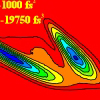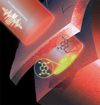For an overview of our research click here.
For short summaries of our projects click here.
Our current research activities include:
- Pulse shaping and characterization of femtosecond pulses
- Biophysical/biomedical applications of nonlinear optical control such
as selective two-photon excitation for microscopy and imaging through biological
tissue
- Laser control of chemical reactions
- Selective excitation of chemical bonds, and ultrafast reaction dynamics
in ground and excited states
- Development of a multidimensional spectroscopic method for identification
of chemicals in a complex mixture
- Quantum computation and quantum information processing with molecular eigenstates
We have developed a method for automated pulse characterization and compensation called MIIPS.(2-7) In MIIPS, a well-known reference function is scanned across the spectrum of the pulse to reveal the unknown phase across the pulse. MIIPS is a single beam method that is fast and accurate. Because it is used together with a pulse shaper, MIIPS can be used to characterize a pulse and to use that knowledge to compensate phase distortions to yield a pulse that is very close to transform limit. We typically can see time-bandwidth products near 1.001 compared to commercial laser pulses which are closer to 1.5.
For questions about the MIIPS device (design, performance, availability) please check this page often, send us an e-mail, or call (517-355-9715 ext 314).
Coherent control of nonlinear laser-matter interactions
We employ phase modulated ultrafast laser pulses for control of nonlinear optical processes in large molecules, proteins, and solid materials by multiphoton intrapulse interference (MII). One of the several ways to achieve phase modulation experimentally is to use Spatial Light Modulators (SLM).(1) The phase across the spectrum of ultrashort pulses affects multiphoton processes, and it can be manipulated to enhance or diminish them.(2) Other goals may include control of 2- and 3-photon processes.(3) We have found that in large molecules in condensed phase MII plays the prevailing role in the multiphoton response.
Unlike the optimal control approach to control problem that yields unintuitive and very complex fields as a solution, we use well-defined phase functions that allows us to simulate the experimental results and to provide a fundamental understanding about the observations.
So far, we have used MII to control two and three photon excitation, second harmonic generation, and continuum generation,(2,3) for selective multiphoton microscopy,(4) for automated pulse optimization,(5) for selectively exciting different molecules in a mixture or similar molecules under different microscopic chemical environments,(6) for functional imaging through biological tissue,(7) and for the identification of chemical agents in mixtures.(8)
References:
1. A. M. Weiner, Femtosecond pulse shaping using spatial light modulators, Rev. Sci. Instr., 71, 1929-1960, (2000)
2. K. A. Walowicz, I. Pastirk, V. V. Lozovoy and M. Dantus, Multiphoton Intrapulse Interference I;Control of multiphoton processes in condensed phase, J. Phys. Chem., 106, 9369-9373, (2002)
3. V. V. Lozovoy, I. Pastirk, K. A. Walowicz and M. Dantus, Multiphoton Intrapulse Interference II. Control of two- and three-photon laser induced fluorescence with shaped pulses, J. Chem. Phys., 118, 3187-3196, (2003)
4. I. Pastirk, J. M. Dela Cruz, K. A. Walowicz, V. V. Lozovoy, and M. Dantus, "Selective two-photon microscopy with shaped femtosecond pulses", Optics Express, 11, 1695-1701 (2003)
5. V. V. Lozovoy, I. Pastirk, M. Dantus, "Multiphoton intrapulse interference 4; Characterization and compensation of the spectral phase of ultrashort laser pulses", 29, 7, 775-777, Optics Letters (2004)
6. J. M. Dela Cruz, I. Pastirk, V. V. Lozovoy, K. A. Walowicz and M. Dantus, "Multiphoton Intrapulse Interference 3: probing microscopic chemical environments", 108, 1, 53-58, J. Phys. Chem. (2004)
7. M. Dantus, V. V. Lozovoy, I. Pastirk, "Measurement and Repair: The femtosecond Wheatstone Bridge", OE Magazine (September 2003)
Funding
Our research has been funded by the following agencies:
National Science Foundation
Department Of Energy
Packard Science and Engineering Fellowship
Beckman Young Investigator Award




